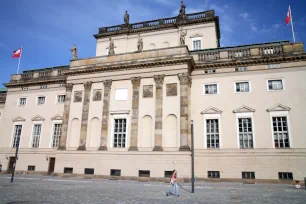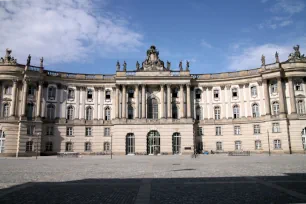Bebelplatz was designed in the eighteenth century as a center for the arts and science. The square, which is located at the Unter den Linden boulevard, is lined with a number of grand buildings.
Origins of the Bebelplatz

When Frederick II became ruler of Prussia in 1740, this patron of the arts envisioned creating a cultural quarter near the city palace. Plans for this quarter were drawn up by the king himself, with assistance from architect Georg Wenzeslaus Von Knobelsdorff. The quarter, which was known as Forum Fridericianum (Frederick’s Forum) included an opera house, a cathedral, an academy, a library, and a royal palace.
The square on the south side of Unter den Linden was later named Opernplatz. It wasn’t until 1947 that this square became known as Bebelplatz, named for August Bebel, a leader of the Social Democratic Party of Germany in the nineteenth century.
The Buildings
Thanks to Frederick’s vision, the buildings around Bebelplatz form a grand architectural ensemble.
State Opera House

The oldest building, designed in Classical style by Georg Wenzeslaus von Knobelsdorff, is the lavish Staatsoper (State Opera House). It opened in 1743 as the Hofoper (Court Opera House). In 1843 the opera house was destroyed by fire. Reconstruction started immediately under the supervision of Carl Ferdinand Langhans.
The opera house was destroyed once again during World War II but was rebuilt in 1955 in accordance with von Knobelsdorff’s plans.
Old Library

Opposite the opera house, on the west side of Bebelplatz, is the Alte Bibliothek (Old Library), the former Royal Prussian Library. The library was built between 1775 and 1780 to a design based on the Michaelertrakt of the Hofburg in Vienna. The curved shape of its grandiose Baroque facade has earned it the nickname Kommode (chest of drawers).
The building is now part of Humboldt University, located across the street on Unter den Linden. Like all buildings on Bebelplatz the library was destroyed during WWII. It was reconstructed in 1963-1968.
St. Hedwig’s Cathedral

Modeled after the Pantheon in Rome, St. Hedwig’s Cathedral graces the south-east perimeter of the Bebelplatz. It was built in 1747 and was the first Catholic Church constructed in Germany after the Protestant Reformation. It was commissioned by Frederick II, who, despite not being religious, was an advocate of freedom of religion.
The cathedral’s shiny green dome is visible from various parts of the city. It was destroyed in 1943 and rebuilt in 1952-1963, but unfortunately with a completely new, modern interior.
Library Memorial

The square used to be planted with grass and shrubs, but it is now completely paved with cobblestones except for a small glass plate. Visitors can peer through the glass in the ground and view rows of empty bookshelves, a monument that commemorates the book burning that happened here on May 10, 1933. On that date, the Nazi minister for propaganda and public enlightenment, Joseph Goebbels, organized a nationwide book burning, with more than 20,000 books that conflicted with Nazi ideology burned on a pyre in the middle of the square.
- Next: Rotes Rathaus
- More Sights & Attractions in Berlin

